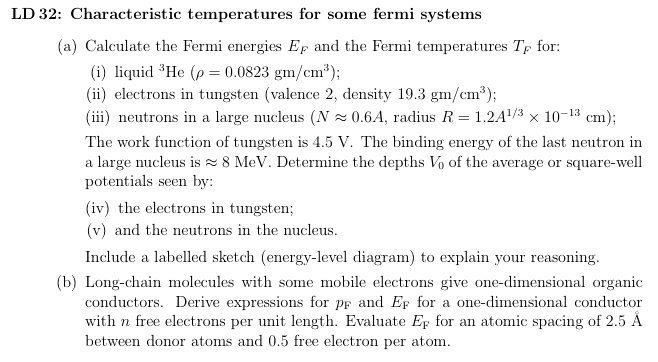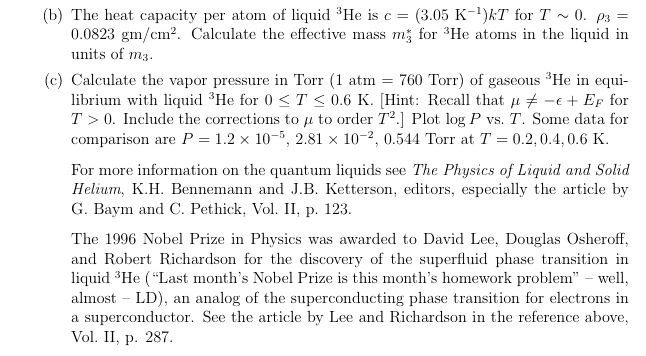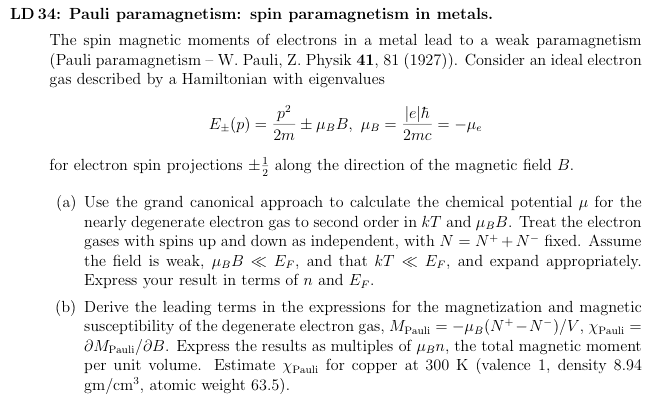
PROBLEM SET 10
Due Friday, April 21, 2006
Reading: Landau and Lifshitz, Secs. 57-61, 63, 106-109

| Comment: The point of this problem is to give you an idea of the range of problems in which a system can be treated in a first approximation as a noninteracting Fermi gas, of the associated Fermi temperatures TF, and the overall energetics. |


| Comment: The problem is simple once you think through how the various energies are related. While the model may seem oversimplified, it actually gives a good description of helium 3 as an ideal "Fermi liquid." The complications of motion in a liquid are subsumed in an average way by the use of an effective mass. This is supposed to incorporate the resistance to the free motion of an atom which results from the medium (a classical picture). The key point for the quantum description is that the possible excitations of the liquid are taken to vary quadratically with the particle momentum. The calculation of the effective mass, or of corrections to the picture, is complicated, but is described in the articles in Bennemann and Ketterson. |

| Comment: The calculation involves the determination of the chemical potential for the system. This is changed by the magnetic interactions, but must agree with the result derived in class for B = 0. Use the method of expansion developed in class for degenerate systems, but note that the expansion variables are different for the two spin configurations even though the chemical potentials must be equal at equilibrium. (Draw a picture to see what is going on!) The calculation of the magnetization is similar. How large, without doing the actual calculation, would you expect M to be? A simple estimate should indicate whether or not your complete answer is correct. |

| Comment: Chandrasekhar's first work on the mass limits on white dwarf stars (stars supported from gravitational collapse by the Fermi pressure of the degenerate electrons) was done at age 19 during his voyage from India to England to take up graduate study at Trinity College, Cambridge, with R.H. Fowler and Dirac. This work was published in Astrophysical J. 74, 81 (1931) (it conflicted with stellar models developed by editors of the then-favored journal, Monthly Notices of the R.A.S.). Landau's independent analysis (Phys. Zeit. der Sowjetunion 1, 285 (1932)) led to the same conclusion, but Landau did not quite believe it and thought some violation of quantum mechanics might be involved! | ||
| The question remained as to what could happen to a collapsed star with a
mass greater than the Chandrasekhar limit M ~ 1.4 M_sun. Baade and Zwicky realized in 1934 that Fermi pressure could support a "neutron star" in
which the electrons and protons combine through the weak interaction
e + p -> n + neutrino, with the neutrino escaping from the star. This
problem was subsequently analyzed by Oppenheimer and Snyder using general
relativity, and it was shown that a neutron star also had a finite upper
limit on its mass, now thought to be about 4.5 M_sun when short-distance
nuclear interactions are taken into account. More massive compact objects are
necessarily black holes, a subject Chandra analyzed in his characteristically
conclusive manner in the mid 1970's.
The first part of this problem is a simplified calculation of the radius of a neutron star with a mass near the Chandrasekhar limit (neutron star masses cluster near this value) using a very simple model for the density profile in the star. Landau and Lifshitz give the actual calculation for an ideal star. The results here show the basic physics. An accurate calculation requires the treatment of the different layers in the star: neutrons at the center, a mixture of neutrons, protons, and electrons at larger radii, and normal nuclear matter near the surface. The simplified calculation is remarkably good. Note that one could do the same type of calculation for a mixture of helium nuclei and degenerate electrons to treat a dwarf star and determine the Chandrasekhar limit for a white dwarf star. Notes: Be sure to use sufficient accuracy in your numerical calculations in part (a). Hint for part (b): do the detailed kinematics for a reaction at the Fermi surface. |